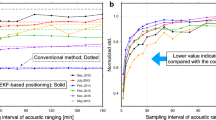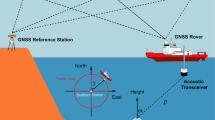Abstract
Traditional Global Navigation Satellite System-Acoustic (GNSS-A) positioning assumes the Layered Model in the sound speed structure, and any of horizontal perturbation of seawater degrades its accuracy. However, the use of the Gradient Model analytically demonstrated that the horizontal gradient of the sound speed structure and displacement can simultaneously be solved using multiple transponders for each of ping. We applied this technique to our observed data and found it unsuitable for real data. We confirmed that a horizontal perturbation with wavelength shorter than the horizontal extent of the transponder array significantly violates the linear approximation in the Gradient Model. Our vertical 2D numerical simulation of internal waves (IWs) forced by tidal oscillation showed that such small-scale IWs could effectively be generated by nonlinear cascade from large-scale IWs of the major tidal constituents. In addition, a small-scale IW in deep water typically has a period of 3–4 h, which degrades positioning accuracy significantly, whereas an IW of much shorter period in shallow water has less effect after removal of the fluctuation by time averaging within a typical observation period. Apparent array position obtained in the synthetic test based on the simulated IW-derived sound speed structure showed features quite similar to that observed in real surveys. To incorporate such deeper perturbation, we proposed a Disturbance Model using dual sea surface platforms, that can solve time-varying perturbation in the vicinity of each transponder.













Similar content being viewed by others
References
Bryden HL (1973) New polynomials for thermal expansion, adiabatic temperature gradient and potential temperature of sea water. Deep Sea Res Oceanogr Abstracts 20:401–408. https://doi.org/10.1016/0011-7471(73)90063-6
Chadwell CD (2013) GPS-acoustic seafloor geodesy using a wave glider. Paper presented at 2013 AGU Fall Meeting, abstract G14A-01, San Francisco
Chadwell CD, Spiess FN (2008) Plate motion at the ridge-transform boundary of the south Cleft segment of the Juan de Fuca Ridge from GPS-Acoustic data. J Geophys Res 113:B04415. https://doi.org/10.1029/2007JB004936
Chen C-T, Millero F (1977) Speed of sound in seawater at high pressure. J Acoust Soc Am 62:1129–1135. https://doi.org/10.1121/1.381646
Chen H-Y, Ikuta R, Lin C-H, Hsu Y-J, Kohmi T, Wang C-C, Yu S-B, Tu Y, Tsuji T, Ando M (2018) Back-arc opening in the western end of the Okinawa Trough revealed from GNSS/acoustic measurements. Geophys Res Lett 45:137–145. https://doi.org/10.1002/2017GL075724
Courant R, Friedrichs K, Lewy H (1967) On the partial difference equations of mathematical physics. IBM J Res Dev 11:215–234. https://doi.org/10.1147/rd.112.0215
Fujita M, Ishikawa T, Mochizuki M et al (2006) GPS/acoustic seafloor geodetic observation: method of data analysis and its application. Earth Planets Space 58:265–275. https://doi.org/10.1186/BF03351923
Gagnon K, Chadwell CD, Norabuena E (2005) Measuring the onset of locking in the Peru-Chile trench with GPS and acoustic measurements. Nature 434:205–208. https://doi.org/10.1038/nature03412
Garrett C, Munk W (1979) Internal waves in the ocean. Ann Rev Fluid Mech 11:339–369. https://doi.org/10.1146/annurev.fl.11.010179.002011
Hofmann-Wellenhof B, Lichtenegger H, Collins J (2001) Global positioning system: theory and practice. Japanese Translation 5th rev. ed. Springer, Tokyo
Honsho C, Kido M (2017) Comprehensive analysis of traveltime data collected through GPS-acoustic observation of seafloor crustal movements. J Geophys Res 122:8583–8599. https://doi.org/10.1002/2017JB014733
Honsho C, Kido M, Tomita F, Uchida N (2019) Offshore postseismic deformation of the 2011 Tohoku earthquake revisited: application of an improved GPS-acoustic positioning mothed considering horizontal gradient of sound speed structure. J Geophys Res 124:5990–6009. https://doi.org/10.1029/2018JB017135
Ikuta R, Tadokoro K, Ando M, Okuda T, Sugimoto S, Takatani K, Yada K, Besana GM (2008) A new GPS-acoustic method for measuring ocean floor crustal deformation: application to the Nankai Trough. J Geophys Res 113:B02401. https://doi.org/10.1029/2006JB004875
Imano M, Kido M, Honsho C, Ohta Y, Takahashi N, Fukuda T, Ochi H, Hino R (2019) Assessment of directional accuracy of GNSS-Acoustic measurement using a slackly moored buoy. Prog Earth Planet Sci 6. https://doi.org/10.1186/s40645-019-0302-1
Kido M (2007) Detecting horizontal gradient of sound speed in ocean. Earth Planets Space 59:e33–e36. https://doi.org/10.1186/BF03352027
Kido M, Fujimoto H, Miura S, Osada Y, Tsuka K, Tabei T (2006) Seafloor displacement at Kumano-nada caused by the 2004 off Kii Peninsula earthquakes, detected through repeated GPS/Acoustic surveys. Earth Planets Space 58:911–915. https://doi.org/10.1186/BF03351996
Kido M, Osada Y, Fujimoto H (2008) Temporal variation of sound speed in ocean: a comparison between GPS/acoustic and in situ measurements. Earth Planets Space 60:229–234. https://doi.org/10.1186/BF03352785
Kido M, Osada Y, Fujimoto H, Hino R, Ito Y (2011) Trench-normal variation in observed seafloor displacements associated with the 2011 Tohoku-Oki earthquake. Geophys Res Lett 38:L24303. https://doi.org/10.1029/2011GL050057
Kido M, Fujimoto H, Hino R, Ohta Y, Osada Y, Iinuma T, Azuma R, Wada I, Miura S, Suzuki S, Tomita F, Imano M (2015) Progress in the project for development of GPS/acoustic technique over the last 4 years. In: Hashimoto M (Ed) International symposium on geodesy for earthquake and natural hazards (GENAH). International Association of Geodesy Symposia vol 145, pp 3–10. Springer, Cham. https://doi.org/10.1007/1345_2015_127
Kido M, Imano M, Ohta Y, Fukuda T, Takahashi N, Tsubone S, Ishihara Y, Ochi H, Imai K, Honsho C, Hino R (2018) Onboard realtime processing of GPS-acoustic data for moored buoy-based observation. J Disaster Res 13(3):472–488. https://doi.org/10.1007/1345_2015_127
Leroy CC, Parthiot F (1998) Depth-pressure relationships in the oceans and seas. J Acoust Soc Am 103:1346–1352. https://doi.org/10.1121/1.421275
Matsumoto K, Takanezawa T, Ooe M (2000) Ocean tide models developed by assimilating TOPEX/POSEIDON altimeter data into hydrodynamical model: a global model and a regional model around Japan. J Oceanography 56:567–581. https://doi.org/10.1023/A:1011157212596
Müller P, Holloway G, Henyey F, Pomphrey N (1986) Nonlinear interactions among internal gravity waves. Rev Geophys 24(3):493–536. https://doi.org/10.1029/RG024i003p00493
Munk W, Wunsch C (1998) Abyssal recipes II: energetics of tidal and wind mixing. Deep Sea Res I 45:1977–2010. https://doi.org/10.1016/S0967-0637(98)00070-3
Nagasawa M, Hibiya T, Niwa Y, Watanabe M (2002) Distribution of fine-scale shear in the deep waters of the North Pacific obtained using expendable current profilers. J Geophys Res 107(C12):3221. https://doi.org/10.1029/2002JC001376
Niwa Y, Hibiya T (2014) Generation of baroclinic tide energy in a global three-dimensional numerical model with different spatial grid resolutions. Ocean Model 80:59–73. https://doi.org/10.1016/j.ocemod.2014.05.003
Sato M, Saito H, Ishikawa T, Matsumoto Y, Fujita M, Mochizuki M, Asada A (2011a) Restoration of interpolate locking after the 2005 Off-Miyagi Prefecture earthquake, detected by GPS/acoustic seafloor geodetic observation. Geophys Res Lett 38:L01312. https://doi.org/10.1029/2010GL045689
Sato M, Ishikawa T, Ujihara N, Yoshida S, Fujita M, Mochizuki M, Asada A (2011b) Displacement above the hypocenter of the 2011 Tohoku-Oki earthquake. Science 332:1395. https://doi.org/10.1126/science.1207401
Spiess FN (1985) Suboceanic geodetic measurements. IEEE Trans Geosci Remote Sens GE-23:502–510. https://doi.org/10.1109/TGRS.1985.289441
Spiess FN, Chadwell CD, Hildebrand JA, Young LE, Purcell GH Jr, Dragert H (1998) Precise GPS/acoustic positioning of seafloor reference points for tectonic studies. Phys Earth Planet Interiors 108:101–112. https://doi.org/10.1016/S0031-9201(98)00089-2
Sugiyama Y, Niwa Y, Hibiya T (2009) Numerically reproduced internal wave spectra in the deep ocean. Geophys Res Lett 36:L07601. https://doi.org/10.1029/2008GL036825
Tadokoro K, Ando M, Ikuta R, Okuda T, Besana G, Sugimoto S, Kuno M (2006) Observation of coseismic seafloor crustal deformation due to M7 class offshore earthquakes. Geophys Res Lett 33:L23306. https://doi.org/10.1029/2006GL026742
Tadokoro K, Nakamura M, Ando M, Kimura H, Watanabe T, Matsuhiro K (2018) Interplate coupling state at the Nansei-shoto (Ryukyu) trench, Japan, deduced from seafloor crustal information measurement. Geophys Res Lett 45:6869–6877. https://doi.org/10.1029/2018GL078655
Tomita F, Kido M, Ohta Y, Iinuma T, Hino R (2017) Along-trench variation in seafloor displacements after the 2011 Tohoku earthquake. Sci Adv 3:e1700113. https://doi.org/10.1126/sciadv.1700113
Wessel P, Smith WHF (1998) New, improved version of the generic mapping tools released. Eos Trans AGU 79(47):579. https://doi.org/10.1029/98EO00426
Yasuda K, Tadokoro K, Taniguchi S, Kimura H, Matsuhiro K (2017) Interplate locking condition derived from seafloor geodetic observation in the shallowest subduction segment at the Central Nankai Trough, Japan. Geophys Res Lett 44:3572–3579. https://doi.org/10.1002/2017GL072918
Yokota Y, Ishikawa T, Watanabe S, Tashiro T, Asada A (2016) Seafloor geodetic constraints on interplate coupling of the Nankai Trough megathrust zone. Nature 534:374–377. https://doi.org/10.1038/nature17632
Yokota Y, Ishikawa T, Watanabe S (2018) Gradient field of undersea sound speed structure extracted from the GNSS-A oceanography. Mar Geophys Res. https://doi.org/10.1007/s11001-018-9362-7
Acknowledgements
This research was supported by JST (Japan Science and Technology Agency) under the SIP Program “Enhancement of Societal Resiliency against Natural Disasters” in 2014–2016 fiscal years and by MEXT (Ministry of Education, Culture, Sports, Science and Technology) through KAKENHI Grant Number 17K18799 in 2017–2018 and 15H04228 in 2015–2018, and activity of the Core Research Cluster of Disaster Science in Tohoku University (a Designated National University) since 2018. The suggestions by two anonymous reviewers significantly made the manuscript improved. Figures were drawn using the Generic Mapping Tools (Wessel and Smith 1998). The original data of sound speed field and synthetic traveltimes produced in this study as well as that of observations are available upon request to the corresponding author.
Author information
Authors and Affiliations
Corresponding author
Additional information
Publisher's Note
Springer Nature remains neutral with regard to jurisdictional claims in published maps and institutional affiliations.
R. Matsui is now moved to a private company. Y. Niwa is now at Center for Ocean Literacy and Education, Graduate School of Education, The University of Tokyo.
Electronic supplementary material
Below is the link to the electronic supplementary material.
Rights and permissions
About this article
Cite this article
Matsui, R., Kido, M., Niwa, Y. et al. Effects of disturbance of seawater excited by internal wave on GNSS-acoustic positioning. Mar Geophys Res 40, 541–555 (2019). https://doi.org/10.1007/s11001-019-09394-6
Received:
Accepted:
Published:
Issue Date:
DOI: https://doi.org/10.1007/s11001-019-09394-6




